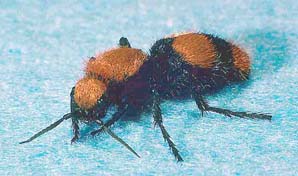Velvet Ant | |
|---|---|
| July 11, 2007 | |
|
Velvet ants are bright-colored wasps. The females are typically wingless, and the males have wings. Velvet ants get their name from the velvetlike hair (setae) that covers their bodies. Many velvet ants that live in hotter, desert areas have very long hair that may trap an insulating coat of air that helps keep the wasp cooler. In desert areas, as well as Illinois, velvet ants are very active during the hot, sunny part of the day, so protection from the heat is needed. Velvet ants are common in southern Illinois, becoming less common farther north, and are essentially absent in northern Illinois.  Most velvet ant species are brightly colored. Females of the most obvious species in Illinois are about 1 inch long and bright orange–red with black bands. They run quickly and nervously about in dry, sandy areas and on sidewalks. where they are easily noticed. Females have long stingers that can protrude from the abdomen about 3/8 of an inch. These stingers are normally kept inside their abdomens until needed for use. Even though some species are commonly called cow killers, their sting is similar to that of other wasps. The males are colored similarly to the females but also have transparent, black wings. Like cicada killers, they fly in areas where females are located but generally fly a few inches above the ground rather than the several feet above the ground typical of cicada killers. Because they fly closer to the ground, male velvet ants are not as noticeable to passersby as cicada killer males. As with cicada killers, male velvet ants cannot sting, as the stinger is a modified egg-laying device. Velvet ants are parasites of bumblebee nests. Adults enter the nests to feed on honey stored there by the bumblebees. Velvet ants have very hard exoskeletons, perhaps to make them impervious to bumblebee stings. Mated female velvet ants lay their eggs into bumblebee pupal cells, laying one egg per pupa. The eggs hatch into larvae that eat the bumblebee pupae and then pupate in the pupal cells. The velvet ant pupae spend the winter in the bumblebee nest, emerging during the following growing season. Bumblebees abandon their nests in the fall, establishing new ones in the spring. Thus, the velvet ant pupae have the nests to themselves during the winter and the following spring. |